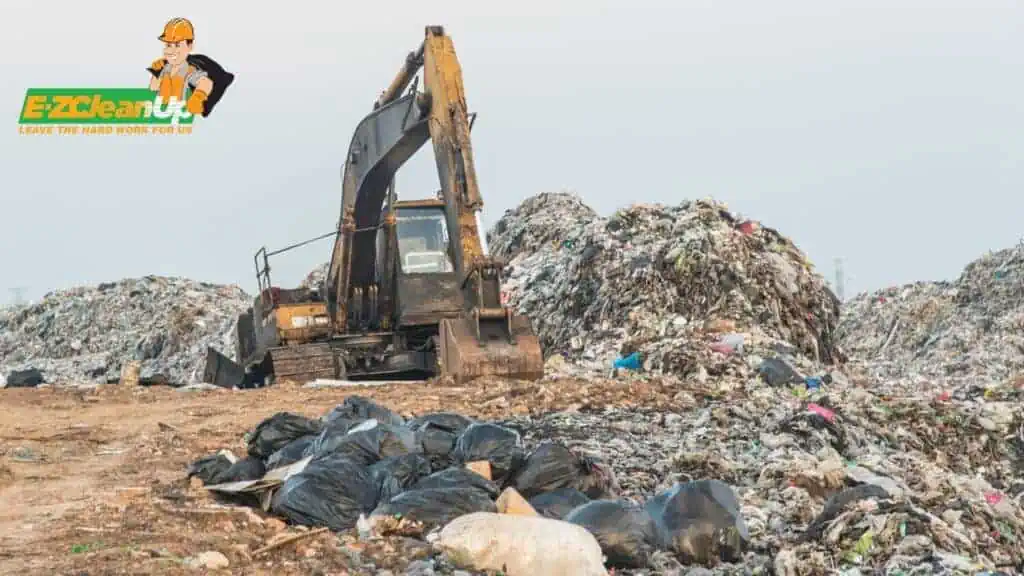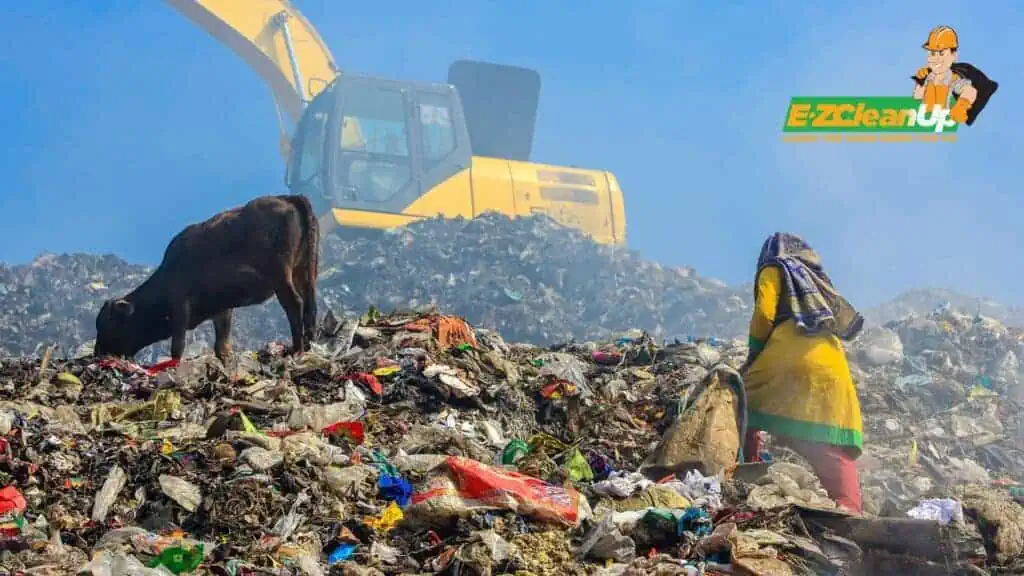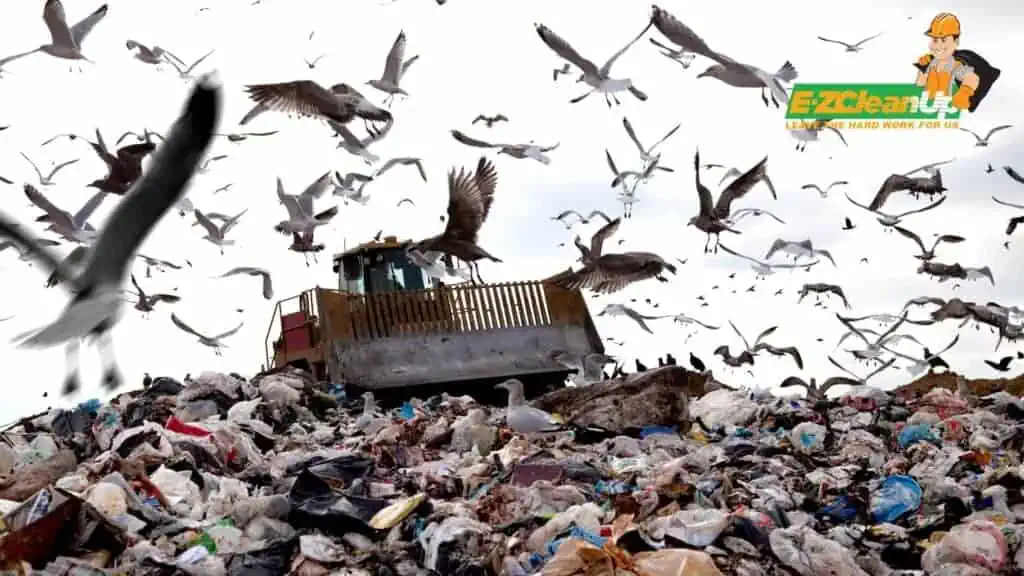A landfill, the oldest method of waste disposal, is a designated area for burying waste materials. However, it poses significant environmental and health hazards, such as air and water pollution, the emission of greenhouse gases, and harmful health impacts on nearby communities.
This guide will cover important points about what is landfill and why is it bad. Let’s begin.

Understanding Landfills: More Than Just Dump Sites
Landfills are essentially areas designated for the disposal of waste that hasn’t been recycled or reused. These sites accumulate a mix of domestic and commercial waste, including both biodegradable and non-biodegradable materials. Although landfills undergo strict regulations and monitoring to ensure compliance with safety standards, they still present significant risks to human health, property, and the environment.
The Negative Impact of Landfills
The U.S. Environmental Protection Agency (EPA) highlights that landfills are prone to leaks, which can lead to the contamination of nearby water sources. This contamination threatens the quality of drinking water for surrounding communities.
Moreover, the EPA identifies landfills as the third-largest source of human-caused methane emissions in the U.S. Methane, about 25 times more effective than carbon dioxide at trapping heat in the atmosphere, significantly contributes to the global climate crisis.
Landfills are not only an environmental hazard but also a health threat. The gases they emit can cause unpleasant odors and are linked to severe health issues, including cancers and birth defects. These sites, even after closure, aren’t entirely safe for development or recreational purposes.
The instability of closed landfills can lead to structural issues like cracks and leaks, which pose ongoing risks. Despite being a common solution for waste disposal, the disadvantages associated with landfills far outweigh their utility.
Unseen Consequences of Landfills
The United States manages over 3,000 active and 10,000 old landfills. While essential for handling solid waste, reducing environmental litter, curbing disease spread, and maintaining community cleanliness, landfills come with significant environmental and social drawbacks.
The Environmental Effects of Landfills
Landfills’ most alarming environmental issue is the emission of methane gas, a byproduct of decomposing organic matter. Methane’s capability to absorb the sun’s heat is 84 times that of carbon dioxide over a 20-year period, positioning it as a formidable greenhouse gas and a key player in climate change.
Landfills don’t just emit methane; they also release carbon dioxide, water vapor, and small amounts of other gases like oxygen, nitrogen, hydrogen, and various organic compounds. These emissions contribute to climate change and, if unregulated, can lead to air pollution and smog.
Another significant impact of landfills is habitat destruction. The average landfill spans 600 acres. This means that in the U.S. alone, up to 1,800,000 acres of wildlife habitat may have been lost to accommodate landfills.
Despite federal mandates for landfills to be lined with plastic or clay to prevent leaks, these barriers are not foolproof. Leaks can lead to the production of leachate, a potentially hazardous liquid that can seep into and contaminate surrounding water bodies, further harming ecosystems.
Leachate often contains high ammonia levels, which in natural ecosystems can transform into nitrate. This process, known as nitrification, can lead to eutrophication—excessive plant growth that depletes oxygen in water bodies, creating “dead zones” where aquatic life cannot survive.

The Social Effects of Landfill Sites
The presence of landfills not only affects the environment but also has notable social impacts, particularly on the health and well-being of nearby communities. People living close to these waste disposal sites face various challenges and risks.
Health Risks and Property Value Impacts
A significant health concern linked to landfills is the heightened risk of congenital malformations in children. A study from New York revealed a 12% increase in the risk of such birth defects among children born to families living within a mile of a hazardous waste landfill site.
In terms of property value, the existence of a large landfill nearby can lower the value of adjacent land by approximately 12.9%. Smaller landfills also affect property values, albeit to a lesser extent, typically resulting in around a 2.5% decrease. These figures underline the negative perception and real impact of landfills on local real estate.
Additional Hazards and Community Impacts
Landfills bring various problems and hazards, including unpleasant odors, smoke, noise pollution, increased insect activity, and potential water supply contamination, all of which degrade the quality of life for nearby residents.
A particularly concerning social issue is the disproportionate placement of landfills in minority and low-income communities. These areas often have less political and financial clout to resist the establishment of these facilities.
It makes them more vulnerable to being chosen as sites for landfills and hazardous waste sites compared to wealthier, more resourceful neighborhoods. This trend highlights a broader issue of environmental justice and inequality.
Key Strategies to Minimize Landfill Waste
While landfills play a crucial role in managing community waste, they also come with significant environmental and health risks. Adopting practices that reduce our reliance on landfills is important for a healthier, more sustainable future.
Here are some of the things we must do to help minimize the waste that goes into landfills:
Embrace Recycling
Each year, recycling diverts a growing amount of waste from landfills. By recycling and upcycling, we can keep plastics and other materials out of natural habitats and repurpose them for additional use.
Say No to Single-Use Plastics
Reducing the use of single-use plastics significantly cuts down the amount of waste heading to landfills.
Composting
In landfills, organic waste doesn’t decompose efficiently due to the lack of oxygen. Composting biodegradable materials ensures they break down properly and don’t end up consuming valuable landfill space.
Zero Waste Lifestyle
Committing to a zero-waste lifestyle not only limits landfill expansion but also minimizes its harmful effects on our environment and health. By focusing on recycling, avoiding single-use plastics, and composting, we can significantly reduce the burden on landfills.
The Dangerous Impact of Landfills on the Environment
Landfills pose a serious threat to our environment. Here are the key reasons why:
Major Pollution Sources
Landfills contribute significantly to air, soil, and water pollution. They are an eyesore, producing unpleasant odors and attracting pests like rats and seagulls, which lead to further environmental issues.
Long-lasting Effects
Clearing or cleaning up landfills is challenging, and their impacts can persist for years. Waste buried in landfills decomposes slowly and poses enduring problems for the environment and future generations.
Toxic Waste Accumulation
Landfills contain a variety of materials, including toxic substances from electronic waste, such as TVs and computers. Hazardous elements like mercury, PVC, acids, arsenic, lead, and cadmium are found in these wastes. Additionally, discarded pharmaceuticals, fertilizers, and expired products add to the toxic mix.
Groundwater Pollution
The leachate, or the liquid that forms when waste decomposes in landfills, is highly toxic. It can contaminate the land, groundwater, and waterways, affecting people and lands for extended periods.
Greenhouse Gas Emissions
One of the most critical environmental threats from landfills is their production of greenhouse gases, especially methane, which is significantly more potent than carbon dioxide. As the third-largest source of methane emissions in the U.S., landfills contribute substantially to global warming and climate change.
Biodiversity Loss
Landfills lead to the loss of approximately 30 to 300 species per hectare. They disrupt local wildlife, encourage species that feed on waste, like crows and rats, and affect vegetation by introducing non-native plant species that outcompete indigenous flora.
Soil and Land Degradation
The accumulation of toxic substances and decaying organic matter in landfills detrimentally impacts soil quality. This degradation can influence crop growth and permanently alter the biodiversity of local plants.

Human Health Impacts of Landfills
Landfills not only pose environmental hazards but also have direct and indirect effects on human health:
Health Risks for Landfill Workers
Workers at landfill sites face significant health threats. Organic household waste, as it ferments, can foster harmful microbial pathogens. Those handling these wastes are at risk of contracting various infectious and chronic diseases.
Broader Human Health Concerns
Exposure to hazardous wastes from landfills impacts overall human health, particularly affecting children. Direct contact with these wastes can lead to diseases and chemical poisoning.
Impact on Water Quality
The leachate from landfills can contaminate bodies of water or seep into groundwater. It affects water sources used for drinking, irrigation, or food production. This contamination cycle can lead to humans consuming toxic substances indirectly.
Air Quality and Odor Issues
The strong odors from landfills can impair breathing, particularly impacting individuals with respiratory conditions and potentially leading to increased hospitalizations.
Pest Infestations
Landfills provide ideal breeding grounds for flies, rodents, and other pests that feed on waste. These pests can invade nearby homes, cause damage, and spread landfill waste into the community.
Finding Alternatives to Landfills
Decomposing waste in landfills emits methane, which leads to an increase in Earth’s temperature and accelerates climate change. Managing and reducing methane emissions from landfills is crucial in addressing climate change.
To get started, here are some environment-friendly alternatives to landfills:
Recycling Initiatives
Recycling stands out as a primary method for reducing landfill use. Common materials like paper, glass, wood, textiles, scrap metal, aluminum, bricks, concrete, and various plastics can undergo recycling processes. This not only prevents them from ending up in landfills but also facilitates their reuse in new forms.
Promoting Composting
Composting is an eco-friendly method that allows organic waste to decompose into nutrient-rich soil additives. This process, easily done in household settings, significantly cuts down on organic waste directed to landfills.
Adoption of Waste-to-Energy Techniques
Converting waste into energy involves the transformation of plastic waste into energy through processes like heating and vaporization, which results in gas production. Not only does this reduce landfill waste and greenhouse gas emissions, but it also contributes to the generation of renewable energy.
Implementing Anaerobic Digestion
Anaerobic digestion involves breaking down organic waste in the absence of oxygen by utilizing bacteria and other microorganisms. While similar to composting, this process uniquely produces methane or natural gas as a byproduct. The gas generated can be used domestically for cooking or in powering machinery.
Future Trends in Landfill Management
Recent trends indicate a decline in landfill numbers. The Environmental Protection Agency (EPA) noted a reduction to 1,956 waste landfills from 6,326 since 1990. Increasingly, businesses are choosing to manage their waste internally rather than outsourcing it. Many are adapting their operations to extract value from waste, such as transforming it into energy at waste-to-energy plants, often co-located with landfills.
Specialists in the field suggest that the future of solid waste management may veer away from landfills, particularly due to the concerns around water contamination. As the usage of landfills decreases, some remaining sites are being repurposed as electricity generators.
The transformation of landfill gas into energy seems set to expand, contingent upon incentives and the volume of organic waste still being deposited in landfills. Ultimately, the evolution of landfills will be influenced by broader societal decisions about managing organic waste and energy production.
Conclusion: Addressing Landfill Challenges
While landfills have historically played an important role in waste management, their impact on the environment and human health can’t be overlooked. From the release of potent greenhouse gases like methane, which contribute to global warming, to the degradation of local ecosystems and water sources, the detrimental effects are far-reaching. Socially, the placement of landfills disproportionately affects lower-income and minority communities, poses health risks, and diminishes property values.
As we progress, the focus is shifting toward innovative waste management methods and reducing our reliance on landfills.
And we are one with this vision. As a junk removal company, EZ CleanUp sees to it that we minimize the waste that we dump into landfills. We prioritize eco-friendly solutions to junk removal, including recycling, repurposing, selling, and donating.
So, if you ever find yourself surrounded by clutter and don’t know what to do with it, don’t dispose of your junk anywhere you please. Instead, call us, and we will handle everything – from collection to dumping. Be part of the solution in reducing landfill problems; call EZ CleanUp for your junk removal needs.














